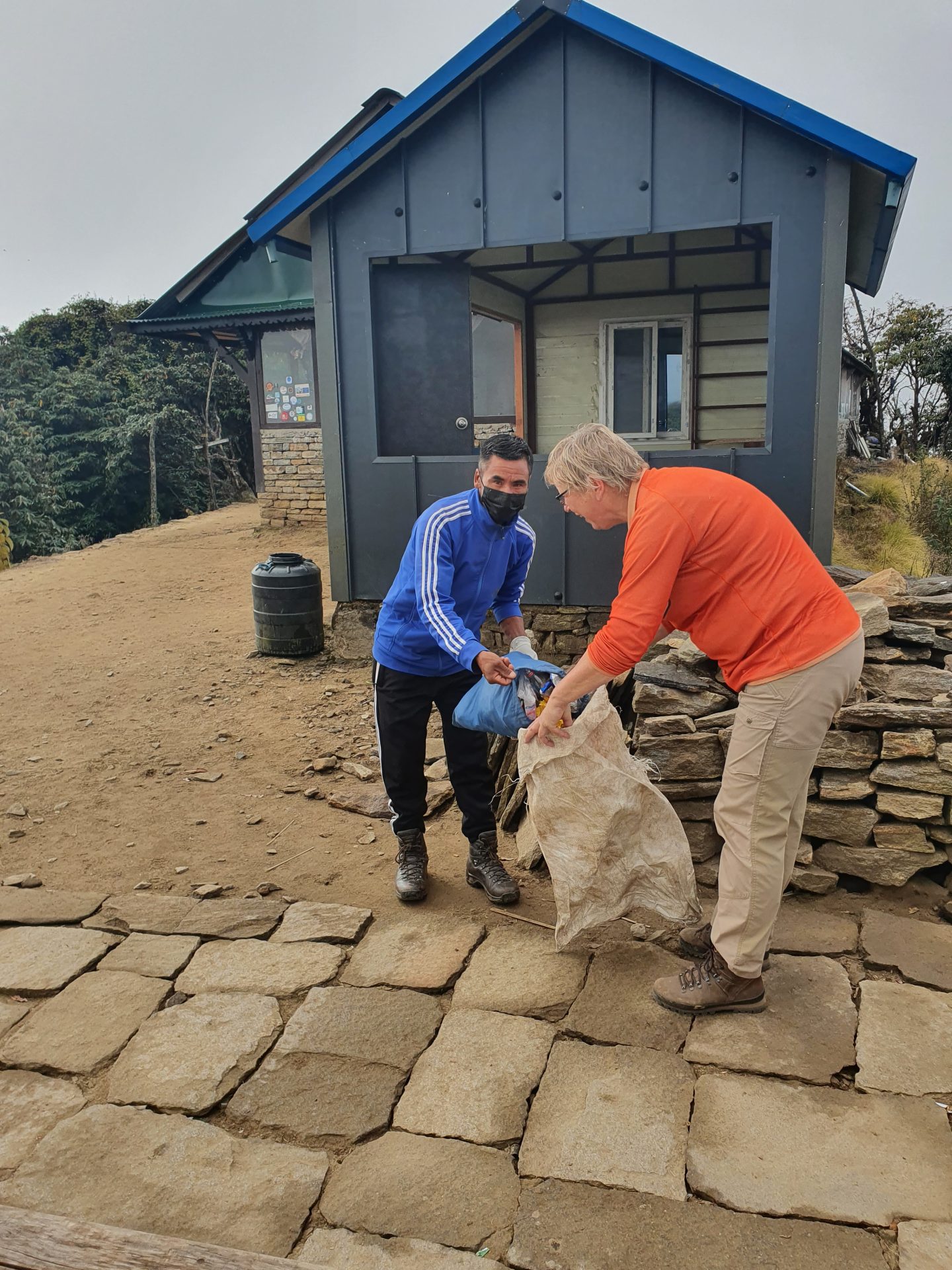Nepal Sanctuary Treks is a responsible trekking company in Nepal that focuses on sustainability and reducing environmental impact. We are certified by Travelife and follow guidelines from the International Porter Protection Group 5. Our Responsible Travel Policy aims to conserve natural resources and prevent pollution during treks.
Environmental Practices
- Refrain from purchasing items made from endangered species.
- Carry out all your belongings, including trash like water bottles, cans, and snack packets.
- Avoid harming the natural environment, such as breaking trees or disturbing flora.
- Do not collect rare flora and fauna when visiting sensitive areas.
- Conserve energy by turning off lights, fans, and air conditioners when not in use.
- Use eco-friendly bags for travel and shopping.
- Be mindful of water usage, especially in areas where water is limited.
- Respect local plants and wildlife; do not disrupt or feed them.
- Use reusable water bottles instead of single-use plastics.
- Properly dispose of non-biodegradable waste and avoid putting debris in bonfires during cooking. Participate in our trash collection initiatives.
- Use eco-friendly soaps and detergents, and ensure wastewater does not flow into water sources.
- Dress warmly to reduce reliance on lodge fireplaces and bonfires.
- Bring used batteries back home, as recycling facilities are limited in Nepal.
Supporting the Local Economy
- Purchase local products and souvenirs to support the local community.
- Dine at local restaurants, shop at local markets, and buy locally grown fruits.
- Show appreciation for good service by providing reasonable tips.
- Instead of giving money to beggars, consider donating to local charities to avoid perpetuating dependency on tourists.
Social Responsibility
- Avoid engaging in or promoting anti-social activities like sex tourism, smuggling, drug trafficking, and child exploitation.
- Strongly oppose child exploitation, including child labor, trafficking, prostitution, and child pornography.
- Respect children’s privacy and dignity, and seek permission before taking their photos.
Please find the code of conduct in Orphanage and School Visit Policy and CAS Trip Code of Conduct (School Visit).
Cultural Etiquette
- Show respect and gratitude by using both hands for giving and receiving.
- Greet others with “Namaste” and join your hands together.
- Avoid offering food after tasting it or eating from a common plate.
- When eating with your fingers, use your right hand.
- Refrain from pointing at people or religious monuments.
- Avoid touching people’s heads and pointing your feet at others.
- Walk clockwise around monasteries, stupas, and temples.
- Remove shoes and dress modestly when entering homes, temples, or monasteries.
- Seek permission before taking photos, especially in sensitive areas, and avoid using flash.
- Dress appropriately during treks, respecting local customs and religious sites.
- Avoid public displays of affection and nudity.
- Learn basic Nepali phrases.
- Dispose of rubbish properly and respect local traditions.
In addition, Travelife has developed Sustainability Codes of Conduct for consumers regarding different activity types. You can download the Sustainability Codes of Conduct:
Artifacts and Antiques
- Exporting items older than 100 years is prohibited. Do not take religious artifacts, such as prayer wheels, statues, or temple ritual objects, from sacred sites.
- Do not purchase furs and skins of wild animals.
- Consider buying unique local souvenirs from nearby shops, like Pashmina and Yak wool shawls, colorful beads, Thangka paintings, singing bowls, and handmade paper items
IUCN Red List
Nepal’s rich biodiversity faces serious threats, and responsible tourism can play a vital role in preserving these unique ecosystems. It is important to emphasize that hunting, poaching, and buying of endangered species are strictly forbidden.
As visitors, it is crucial to be aware of the following guidelines:
- No Hunting: It is illegal to hunt any wildlife in Nepal, especially those listed on the IUCN Red List. Engaging in hunting activities can result in severe penalties, including imprisonment.
- No Poaching: Poaching, the illegal capturing or killing of wildlife, is a significant threat to many endangered species in Nepal. Tourists should report any suspicious activities related to poaching to local authorities or conservation organizations.
- No Buying: Purchasing products made from endangered species, such as ivory, rhino horn, or other wildlife products, is illegal and contributes to the further decline of these species. Refrain from buying such items and report any shops or individuals involved in this illegal trade.
- Respect Protected Areas: Nepal has designated numerous national parks, wildlife reserves, and conservation areas to safeguard its unique biodiversity. Visitors should adhere to the rules and regulations within these protected areas, such as staying on designated trails and not disturbing wildlife.
- Support Conservation Efforts: Consider supporting local and international conservation organizations working in Nepal through donations or volunteering opportunities. Your contributions can help protect and restore endangered species and their habitats.
- Educate Yourself: Educate yourself about the species you may encounter in Nepal and their conservation status. Knowing which animals and plants are endangered will help you make responsible choices during your visit.
IUCN Red list of Flora and Fauna in Nepal
Mammals:
- Bengal Tiger (Panthera tigris tigris) – Endangered
- Snow Leopard (Panthera uncia) – Vulnerable
- Red Panda (Ailurus fulgens) – Endangered
- Asian Elephant (Elephas maximus) – Endangered
- Indian Rhinoceros (Rhinoceros unicornis) – Vulnerable
Birds:
- Bengal Florican (Houbaropsis bengalensis) – Critically Endangered
- White-rumped Vulture (Gyps bengalensis) – Critically Endangered
- Slender-billed Vulture (Gyps tenuirostris) – Critically Endangered
- Yellow-breasted Bunting (Emberiza aureola) – Endangered
- Sarus Crane (Grus antigone) – Vulnerable
Reptiles:
- Gharial (Gavialis gangeticus) – Critically Endangered
- Ganges Softshell Turtle (Aspideretes gangeticus) – Critically Endangered
- Indian Star Tortoise (Geochelone elegans) – Vulnerable
Amphibians:
- Himalayan Newt (Tylototriton verrucosus) – Near Threatened
- Himalayan Salamander (Tylototriton himalayanus) – Near Threatened
Plants:
- Yew (Taxus contorta) – Vulnerable
- Blue Vanda Orchid (Vanda coerulea) – Vulnerable
- Red Panda Food Plant (Rheum nobile) – Vulnerable
- Juniper Species (Juniperus spp.) – Vulnerable
- Himalayan Birch (Betula utilis) – Vulnerable









